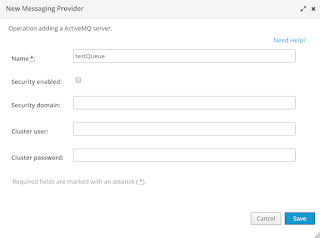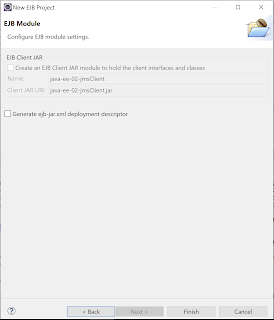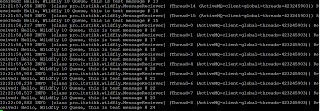Enable JMS(Activemq) in Wildfly
In Wildfly JMS, Activemq is used for message broker. In order to enable message broker in Wildfly. You need to use standalone-full.xml instead of standalone.xml. To use use standalone-full.xml, you need to change currently standalone.xml to other file name like (standalone.xml.org), then you rename the standalone-full.xml to standalone.xml.
$cd $JBOSS_HOME/standalone/configuration
$mv standalone.xml standalone.xml.org
$mv standalone-full.xml standalone.xml
$mv standalone.xml standalone.xml.org
$mv standalone-full.xml standalone.xml
Next is to restart your server.
$cd $JBOSS_HOME/bin
$bash startup.sh
To create message queue, you can use admin console to create queue by configuration ----> Subsystems ----> Messaging- ActiveMQ$bash startup.sh
 |
| Go to Messagin ActiveMQ |
 |
| Create Messaging Provider |
 |
| Create Messaging Provider |
 |
| Create Message Queue |
 |
| Add Queue |
 |
| Finish |
 |
| Restart Server |
Now you have your message queue for asynchronized communication.
Create Message Producer
Next is to create your Message Producer (message sender or generator). To create message producer you just create an EJB project. |
| Select EJB Project |
 |
| Put EJB Project |
 |
| Click Next |
 |
| Finish |
 |
| Create Class |
package pro.itstikk.wildfly;
import javax.annotation.Resource;
import javax.ejb.LocalBean;
import javax.ejb.Stateless;
import javax.inject.Inject;
import javax.jms.JMSContext;
import javax.jms.Queue;
/**
* Session Bean implementation class MessageSender
*/
@Stateless(mappedName = "messageSender")@LocalBean
public class MessageSender {
/**
* Default constructor.
*/
public MessageSender() {
super();
}
private Queue testQueue;
@Inject
private JMSContext jmsContext;
public void enqueue(final String message) {
jmsContext.createProducer().send(testQueue, message);
}
}
Message Consumer
Next is to create message receiver (Message Driven Bean). |
| Create Message Driven Bean |
 |
| Finish |
package pro.itstikk.wildfly;
import java.util.logging.Logger;
import javax.ejb.ActivationConfigProperty;
import javax.ejb.MessageDriven;
import javax.jms.JMSException;
import javax.jms.Message;
import javax.jms.MessageListener;
import javax.jms.TextMessage;
/**
* Message-Driven Bean implementation class for: MessageReciever
*/
@MessageDriven(
activationConfig = { @ActivationConfigProperty(
propertyName = "destination", propertyValue = "testQueue"), @ActivationConfigProperty(
propertyName = "destinationType", propertyValue = "javax.jms.Queue")
},
mappedName = "testQueue")
public class MessageReciever implements MessageListener {
private final static Logger LOGGER = Logger.getLogger(MessageReciever.class.toString());
/**
* Default constructor.
*/
public MessageReciever() {
super();
}
/**
* @see MessageListener#onMessage(Message)
*/
public void onMessage(Message message) {
if (message instanceof TextMessage) {
try {
final String text = ((TextMessage) message).getText();
LOGGER.info(() -> "Received: " + text);
} catch (final JMSException e) {
throw new RuntimeException(e);
}
}
}
}
import java.util.logging.Logger;
import javax.ejb.ActivationConfigProperty;
import javax.ejb.MessageDriven;
import javax.jms.JMSException;
import javax.jms.Message;
import javax.jms.MessageListener;
import javax.jms.TextMessage;
/**
* Message-Driven Bean implementation class for: MessageReciever
*/
@MessageDriven(
activationConfig = { @ActivationConfigProperty(
propertyName = "destination", propertyValue = "testQueue"), @ActivationConfigProperty(
propertyName = "destinationType", propertyValue = "javax.jms.Queue")
},
mappedName = "testQueue")
public class MessageReciever implements MessageListener {
private final static Logger LOGGER = Logger.getLogger(MessageReciever.class.toString());
/**
* Default constructor.
*/
public MessageReciever() {
super();
}
/**
* @see MessageListener#onMessage(Message)
*/
public void onMessage(Message message) {
if (message instanceof TextMessage) {
try {
final String text = ((TextMessage) message).getText();
LOGGER.info(() -> "Received: " + text);
} catch (final JMSException e) {
throw new RuntimeException(e);
}
}
}
}
Test your messaging class, you can create web dynamic project. I have create my web project and create MessageBean class and send.xhtml file.
package com.jsf.bean;
import javax.ejb.EJB;
import javax.enterprise.context.RequestScoped;
import javax.inject.Named;
import pro.itstikk.wildfly.MessageSender;
@Named("messageBean")
@RequestScoped
public class MesssageBean {
@EJB
private MessageSender messageSender;
private String message;
public String getMessage() {
return message;
}
public void setMessage(String message) {
this.message = message;
}
public String send() {
messageSender.enqueue(message);
return "save.xhtml";
}
}
Next is to create send.xhtmlimport javax.ejb.EJB;
import javax.enterprise.context.RequestScoped;
import javax.inject.Named;
import pro.itstikk.wildfly.MessageSender;
@Named("messageBean")
@RequestScoped
public class MesssageBean {
@EJB
private MessageSender messageSender;
private String message;
public String getMessage() {
return message;
}
public void setMessage(String message) {
this.message = message;
}
public String send() {
messageSender.enqueue(message);
return "save.xhtml";
}
}
<!DOCTYPE html PUBLIC "-//W3C//DTD XHTML 1.0 Transitional//EN" "http://www.w3.org/TR/xhtml1/DTD/xhtml1-transitional.dtd">
<html xmlns="http://www.w3.org/1999/xhtml"
xmlns:rich="http://richfaces.org/rich"
xmlns:ui="http://java.sun.com/jsf/facelets"
xmlns:f="http://java.sun.com/jsf/core"
xmlns:a4j="http://richfaces.org/a4j"
xmlns:h="http://java.sun.com/jsf/html">
<h:head></h:head>
<body>
<rich:panel>
<f:facet name="header">
Write your own custom rich components with built-in AJAX support
</f:facet>
<h:form>
<p>
<h:outputLabel value="firstname: " />
<rich:inplaceInput value="#{messageBean.message}" defaultLabel="firstname"/>
</p>
<h:commandButton action="#{messageBean.send}" value="send" />
</h:form>
</rich:panel>
</body>
</html>
Now you can see as below.<html xmlns="http://www.w3.org/1999/xhtml"
xmlns:rich="http://richfaces.org/rich"
xmlns:ui="http://java.sun.com/jsf/facelets"
xmlns:f="http://java.sun.com/jsf/core"
xmlns:a4j="http://richfaces.org/a4j"
xmlns:h="http://java.sun.com/jsf/html">
<h:head></h:head>
<body>
<rich:panel>
<f:facet name="header">
Write your own custom rich components with built-in AJAX support
</f:facet>
<h:form>
<p>
<h:outputLabel value="firstname: " />
<rich:inplaceInput value="#{messageBean.message}" defaultLabel="firstname"/>
</p>
<h:commandButton action="#{messageBean.send}" value="send" />
</h:form>
</rich:panel>
</body>
</html>
 |
| Input Message |
 |
| Message Show Here |
Connecting and Send message to remote Message Queue
In order to send to and/or receiver message from remote queue in Wildfly Messaging service, you need to- create user to access JMS Queue.
- export your message.
- Create message sender to and receiver from target queue.
First, you need to create user to access remote queue.
$cd $JBOSS_HOME/bin
$bash add-user.sh -a -u 'jms-user' -p 'P@assword1!' -g 'guest'
Next is to export queue. In order to export your queue for remote connection, you need to edit your configuration file (standalone-full.xml)
$bash add-user.sh -a -u 'jms-user' -p 'P@assword1!' -g 'guest'
$cd $JBOSS_HOME/standalone/configuration
$vim standalone-full.xml
And edit as below.
$vim standalone-full.xml
<server name="testQueue">
<security enabled="false"/>
<jms-queue name="testQueue" entries="java:/queue/test java:/jboss/exported/jms/queue/test"/>
</server>
 |
| Export queue |
package pro.itstikk.jms.app;
import static org.junit.Assert.assertEquals;
import java.util.Properties;
import javax.jms.ConnectionFactory;
import javax.jms.Destination;
import javax.jms.JMSConsumer;
import javax.jms.JMSContext;
import javax.naming.Context;
import javax.naming.InitialContext;
import org.junit.Test;
public class TestJMSProducer {
private String MESSAGE = "Hello, Wildfly 10 Queue, this is test message";
private String CONNECTION_FACTORY = "jms/RemoteConnectionFactory";
private String DESTINATION = "jms/queue/test";
//jms/queue/ExampleQueue
@Test
public void testSendReceive() throws Exception {
Context namingContext = null;
JMSContext context = null;
try {
// Set up the namingContext for the JNDI lookup
final Properties env = new Properties();
env.put(Context.INITIAL_CONTEXT_FACTORY,
"org.jboss.naming.remote.client.InitialContextFactory");
env.put(Context.PROVIDER_URL, "http-remoting://wildfly.itstikk.pro:8080");
env.put(Context.SECURITY_PRINCIPAL, "jms-user");
env.put(Context.SECURITY_CREDENTIALS, "P@ssword1!");
namingContext = new InitialContext(env);
ConnectionFactory connectionFactory = (ConnectionFactory) namingContext
.lookup(CONNECTION_FACTORY);
System.out.println("Got ConnectionFactory " + CONNECTION_FACTORY);
Destination destination = (Destination) namingContext
.lookup(DESTINATION);
System.out.println("Got JMS Endpoint " + DESTINATION);
// Create the JMS context
context = connectionFactory.createContext("jms-user", "P@ssword1!");
for (int i=0;i<1000;i++) {
context.createProducer().send(destination, MESSAGE+" # "+i);
}
System.out.println("Sent message " + MESSAGE);
System.out.println("==================================================== ");
System.out.println("Finished !");
assert(true);
} catch (Exception e) {
System.out.println(e.getMessage());
throw e;
} finally {
if (namingContext != null) {
namingContext.close();
}
// closing the context takes care of consumer too
if (context != null) {
context.close();
}
}
}
}
For consumer which remotely consume message from the queue you can create as belowimport static org.junit.Assert.assertEquals;
import java.util.Properties;
import javax.jms.ConnectionFactory;
import javax.jms.Destination;
import javax.jms.JMSConsumer;
import javax.jms.JMSContext;
import javax.naming.Context;
import javax.naming.InitialContext;
import org.junit.Test;
public class TestJMSProducer {
private String MESSAGE = "Hello, Wildfly 10 Queue, this is test message";
private String CONNECTION_FACTORY = "jms/RemoteConnectionFactory";
private String DESTINATION = "jms/queue/test";
//jms/queue/ExampleQueue
@Test
public void testSendReceive() throws Exception {
Context namingContext = null;
JMSContext context = null;
try {
// Set up the namingContext for the JNDI lookup
final Properties env = new Properties();
env.put(Context.INITIAL_CONTEXT_FACTORY,
"org.jboss.naming.remote.client.InitialContextFactory");
env.put(Context.PROVIDER_URL, "http-remoting://wildfly.itstikk.pro:8080");
env.put(Context.SECURITY_PRINCIPAL, "jms-user");
env.put(Context.SECURITY_CREDENTIALS, "P@ssword1!");
namingContext = new InitialContext(env);
ConnectionFactory connectionFactory = (ConnectionFactory) namingContext
.lookup(CONNECTION_FACTORY);
System.out.println("Got ConnectionFactory " + CONNECTION_FACTORY);
Destination destination = (Destination) namingContext
.lookup(DESTINATION);
System.out.println("Got JMS Endpoint " + DESTINATION);
// Create the JMS context
context = connectionFactory.createContext("jms-user", "P@ssword1!");
for (int i=0;i<1000;i++) {
context.createProducer().send(destination, MESSAGE+" # "+i);
}
System.out.println("Sent message " + MESSAGE);
System.out.println("==================================================== ");
System.out.println("Finished !");
assert(true);
} catch (Exception e) {
System.out.println(e.getMessage());
throw e;
} finally {
if (namingContext != null) {
namingContext.close();
}
// closing the context takes care of consumer too
if (context != null) {
context.close();
}
}
}
}
package pro.itstikk.jms.app;
import static org.junit.Assert.assertEquals;
import java.util.Properties;
import javax.jms.ConnectionFactory;
import javax.jms.Destination;
import javax.jms.JMSConsumer;
import javax.jms.JMSContext;
import javax.naming.Context;
import javax.naming.InitialContext;
import org.junit.Test;
public class TestJMSConsumer {
private String CONNECTION_FACTORY = "jms/RemoteConnectionFactory";
private String DESTINATION = "jms/queue/test";
//jms/queue/ExampleQueue
@Test
public void testSendReceive() throws Exception {
Context namingContext = null;
JMSContext context = null;
try {
// Set up the namingContext for the JNDI lookup
final Properties env = new Properties();
env.put(Context.INITIAL_CONTEXT_FACTORY,
"org.jboss.naming.remote.client.InitialContextFactory");
env.put(Context.PROVIDER_URL, "http-remoting://wildfly.itstikk.pro:8080");
env.put(Context.SECURITY_PRINCIPAL, "jms-user");
env.put(Context.SECURITY_CREDENTIALS, "P@ssword1!");
namingContext = new InitialContext(env);
ConnectionFactory connectionFactory = (ConnectionFactory) namingContext
.lookup(CONNECTION_FACTORY);
System.out.println("Got ConnectionFactory " + CONNECTION_FACTORY);
Destination destination = (Destination) namingContext
.lookup(DESTINATION);
System.out.println("Got JMS Endpoint " + DESTINATION);
// Create the JMS context
context = connectionFactory.createContext("jms-user", "P@ssword1!");
// Create the JMS consumer
JMSConsumer consumer = context.createConsumer(destination);
//Then receive the same number of messages that were sent
String text = consumer.receiveBody(String.class, 5000);
if (text == null) System.out.println("No message Received! Maybe another Consumer listening on the Queue ??");
System.out.println("Received message with content " + text);
//assertEquals(text,MESSAGE);
assert(true);
} catch (Exception e) {
System.out.println(e.getMessage());
throw e;
} finally {
if (namingContext != null) {
namingContext.close();
}
// closing the context takes care of consumer too
if (context != null) {
context.close();
}
}
}
}
For your maven pom.xml, you can addimport static org.junit.Assert.assertEquals;
import java.util.Properties;
import javax.jms.ConnectionFactory;
import javax.jms.Destination;
import javax.jms.JMSConsumer;
import javax.jms.JMSContext;
import javax.naming.Context;
import javax.naming.InitialContext;
import org.junit.Test;
public class TestJMSConsumer {
private String CONNECTION_FACTORY = "jms/RemoteConnectionFactory";
private String DESTINATION = "jms/queue/test";
//jms/queue/ExampleQueue
@Test
public void testSendReceive() throws Exception {
Context namingContext = null;
JMSContext context = null;
try {
// Set up the namingContext for the JNDI lookup
final Properties env = new Properties();
env.put(Context.INITIAL_CONTEXT_FACTORY,
"org.jboss.naming.remote.client.InitialContextFactory");
env.put(Context.PROVIDER_URL, "http-remoting://wildfly.itstikk.pro:8080");
env.put(Context.SECURITY_PRINCIPAL, "jms-user");
env.put(Context.SECURITY_CREDENTIALS, "P@ssword1!");
namingContext = new InitialContext(env);
ConnectionFactory connectionFactory = (ConnectionFactory) namingContext
.lookup(CONNECTION_FACTORY);
System.out.println("Got ConnectionFactory " + CONNECTION_FACTORY);
Destination destination = (Destination) namingContext
.lookup(DESTINATION);
System.out.println("Got JMS Endpoint " + DESTINATION);
// Create the JMS context
context = connectionFactory.createContext("jms-user", "P@ssword1!");
// Create the JMS consumer
JMSConsumer consumer = context.createConsumer(destination);
//Then receive the same number of messages that were sent
String text = consumer.receiveBody(String.class, 5000);
if (text == null) System.out.println("No message Received! Maybe another Consumer listening on the Queue ??");
System.out.println("Received message with content " + text);
//assertEquals(text,MESSAGE);
assert(true);
} catch (Exception e) {
System.out.println(e.getMessage());
throw e;
} finally {
if (namingContext != null) {
namingContext.close();
}
// closing the context takes care of consumer too
if (context != null) {
context.close();
}
}
}
}
<properties>
<version.wildfly>10.0.0.Final</version.wildfly>
</properties>
<dependencies>
<dependency>
<groupId>org.wildfly</groupId>
<artifactId>wildfly-jms-client-bom</artifactId>
<version>${version.wildfly}</version>
<type>pom</type>
</dependency>
<dependency>
<groupId>junit</groupId>
<artifactId>junit</artifactId>
<version>4.11</version>
</dependency>
</dependencies>
<version.wildfly>10.0.0.Final</version.wildfly>
</properties>
<dependencies>
<dependency>
<groupId>org.wildfly</groupId>
<artifactId>wildfly-jms-client-bom</artifactId>
<version>${version.wildfly}</version>
<type>pom</type>
</dependency>
<dependency>
<groupId>junit</groupId>
<artifactId>junit</artifactId>
<version>4.11</version>
</dependency>
</dependencies>
After you execute program you could see as below.
Reference

No comments:
Post a Comment